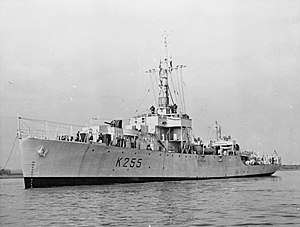HMS Ballinderry (K255)
HMS Ballinderry was a River-class frigate of the Royal Navy which served during the Second World War.
 HMS Ballinderry | |
| History | |
|---|---|
| Name: | Ballinderry |
| Ordered: | 20 June 1941 |
| Builder: | |
| Laid down: | 6 November 1941 |
| Launched: | 7 December 1942 |
| Commissioned: | 2 September 1943 |
| Identification: | Pennant number: K255 |
| Fate: | Scrapped, 7 July 1961 |
| General characteristics | |
| Displacement: |
|
| Length: | |
| Beam: | 36 ft 6 in (11.1 m) |
| Draught: | 9 ft (2.7 m); 13 ft (4.0 m) (deep load) |
| Propulsion: |
|
| Speed: |
|
| Range: | 7,200 nautical miles (13,300 km; 8,300 mi) at 12 knots (22 km/h; 14 mph) with;440 long tons (450 t; 490 short tons) oil fuel |
| Complement: | 107 |
| Armament: |
|
Ballinderry was ordered 20 June 1941 as part of the River-class building programme.[1] The vessel was laid down on 6 November 1941 by Blyth Shipbuilding & Drydock Co. Ltd at Blyth and launched 7 December 1942.[1][2]
War service
After commissioning and trials, Ballinderry conducted work up exercises at Tobermory before commencing operations as a convoy escort. On 10 January 1945, Ballinderry, along with HMS Kilbirnie, rescued 50 survivors from the British Merchant vessel Blackheath that had been torpedoed and damaged by U-870, west of Gibraltar.[3][4]
Postwar service
Ballinderry was reduced to reserve at Harwich in 1947. The ship was refitted at Liverpool in 1951, before returning to reserve at Harwich, where she remained until 1954. In 1955, Ballinderry, still in reserve, moved to Barry in Wales. On 7 July 1961 the frigate was sold to Thos W Ward for scrapping at their Barrow breaking yard.[5]
References
Footnotes
- "HMS Ballinderry (K255)". uboat.net. Retrieved 15 March 2020.
- Colledge, J. J.; Warlow, Ben (2010). Ships of the Royal Navy: The Complete Record of all Fighting Ships of the Royal Navy from the 15th Century to the Present (4 ed.). Casemate Publishers. p. 485. ISBN 1612000274.
- "RIVER-CLASS FRIGATES, Part 1 of 6, Royal Navy (i)". naval-history.net. Retrieved 18 March 2020.
- "HMS Ballinderry". uboat.net. Retrieved 18 March 2020.
- Critchley 1986, p. 27
Sources
- Colledge, J. J.; Warlow, Ben. (2002) Ships of the Royal Navy: The Complete Record of all Fighting Ships of the Royal Navy from the 15th Century to the Present 4th Edition. Casemate Publishers ISBN 1-61200-027-4
- Critchley, Mike (1986). British Warships Since 1945: Part 5 Frigates. Liskeard, UK: Maritime Books. ISBN 0-907771-13-0.CS1 maint: ref=harv (link)
External links
![]()